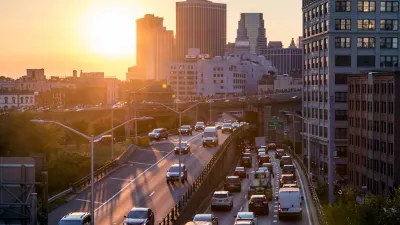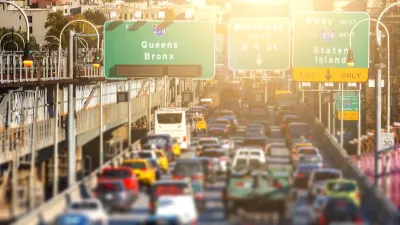Improved transit service could make a major difference in how the program is received by New Yorkers.

“Few good ideas have been resisted as loudly as New York’s plan to charge a toll to drivers entering Manhattan ($15 for most) and use the money to improve public transit,” writes Liza Featherstone in The New Republic.
Although New York’s policy does still have flaws that must be fixed—insufficient exemptions for low-income drivers, for instance—the populist argument against congestion pricing is mostly disingenuous. Only 4 percent of outer-borough New Yorkers drive to Manhattan to work; 57 percent take public transit. And only 2 percent of low-income outer-borough New Yorkers, specifically, would be asked to pay a congestion fee as part of their commute; 61 percent take public transit.
For the policy to gain and maintain public support, Featherstone writes that a large number of New Yorkers must experience its benefits quickly — meaning, better transit service and reduced congestion. “Public transit is one of the least abstract political issues for New Yorkers, affecting where we can work, whether we can get there in time, and whether we can pick up our kids on time at the end of the day.” This is why, Featherstone writes, the ‘Get Congestion Pricing Right’ proposal from Assemblyman Zohran Mamdani, which calls for making an additional 15 bus routes free and increasing bus frequency, could make the difference in how the program is received.
FULL STORY: How to Fix New York City’s Latest Controversial Policy

Planetizen Federal Action Tracker
A weekly monitor of how Trump’s orders and actions are impacting planners and planning in America.

Maui's Vacation Rental Debate Turns Ugly
Verbal attacks, misinformation campaigns and fistfights plague a high-stakes debate to convert thousands of vacation rentals into long-term housing.

Cuomo Is the Candidate of Both NIMBYs and Developers. What Gives?
In the New York City mayoral race, odd bedfellows align to preserve the housing status quo.

The Subversive Car-Free Guide to Trump's Great American Road Trip
Car-free ways to access Chicagoland’s best tourist attractions.

San Antonio and Austin are Fusing Into one Massive Megaregion
The region spanning the two central Texas cities is growing fast, posing challenges for local infrastructure and water supplies.

Charlottesville Temporarily Has No Zoning Code
A judge ordered the Virginia city to throw out its newly revised zoning code, leaving permitting for new development in legal limbo.
Urban Design for Planners 1: Software Tools
This six-course series explores essential urban design concepts using open source software and equips planners with the tools they need to participate fully in the urban design process.
Planning for Universal Design
Learn the tools for implementing Universal Design in planning regulations.
Heyer Gruel & Associates PA
JM Goldson LLC
Custer County Colorado
City of Camden Redevelopment Agency
City of Astoria
Transportation Research & Education Center (TREC) at Portland State University
Jefferson Parish Government
Camden Redevelopment Agency
City of Claremont





























